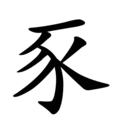Hello, you have come here looking for the meaning of the word
豕 . In DICTIOUS you will not only get to know all the dictionary meanings for the word
豕 , but we will also tell you about its etymology, its characteristics and you will know how to say
豕 in singular and plural. Everything you need to know about the word
豕 you have here. The definition of the word
豕 will help you to be more precise and correct when speaking or writing your texts. Knowing the definition of
豕 , as well as those of other words, enriches your vocabulary and provides you with more and better linguistic resources.
Translingual
Stroke order
There are typographical differences in this character in different fonts – in Japanese printing, the last two strokes may connect to the top stroke, as in right of 衣 , while in handwriting and many other fonts, those strokes connect to the central curving stroke.
Depending on the font, the character 家 (Japanese) / 家 (Traditional Chinese) may also have either of these variations.
Han character 豕 Kangxi radical 152, 豕 +0, 7 strokes, cangjie input 一尸竹人 (MSHO ), four-corner 10232 , composition ⿱一 𧰨 (G H T ) or ⿸𬺻 ⿸丿 ㇏ (G ) or ⿸𬺻 ⿱丿 ㇏ (H T ) or ⿸𬺻 ⿺㇏ 丿 (J K V ))
Kangxi radical #152, ⾗
Derived characters Appendix:Chinese radical/豕 啄 , 𡱰 , 逐 , 㭬 , 烼 , 㒮 , 琢 , 䖶 , 甤 , 䀃 , 蟸 , 㒸 , 冡 , 家 , 䆥 , 𦊽 , 𩆬 , 圂 , 嶳 , 㯻 , 㒪 , 𡁷 , 㻹 , 瓥 , 㽔
See also
References Kangxi Dictionary: page 1194 , character 4
Dai Kanwa Jiten: character 36337
Dae Jaweon: page 1657, character 1
Hanyu Da Zidian (first edition): volume 6, page 3610, character 1
Unihan data for U+8C55
Chinese
Glyph origin Pictogram (象形 亥 𢑓 (male pig), and 豖 (castrated male pig). See also the original version on oracle bones of 敢 .
Related to 㒸 , in which however the pig is a phonetic component.
Etymology Possibly from Austroasiatic Schuessler, 2007 ). Compare Proto-Mon-Khmer *liik ~ *lik ( “ pig ” ) and Mon ကၠိက် ( kloik , “ pig ” ) . Also occurs in the Cai-Long languages , from which Hölzl (2021) derives the name Ta-Li for the aforementioned language subgroup.
Pronunciation
Baxter –Sagart system 1.1 (2014 )
Character
豕
Reading #
1/1
Modern
shǐ
Middle
‹ syeX ›
Old
/*l̥ajʔ/
English
swine
Notes for Old Chinese notations in the Baxter–Sagart system:
* Parentheses "()" indicate uncertain presence;
* Period "." indicates syllable boundary.
Zhengzhang system (2003)
Character
豕
Reading #
1/1
No.
11509
Phonetic
豕
Rime
脂
Rime
0
Corresponding
弛
Old
/*hliʔ/
Definitions 豕
( obsolete ) pig ; boar
有 豕 白 蹢 、烝 涉 波 矣 。From: The Classic of Poetry c. th – 7th centuries BCE James Legge 's versionYǒu shǐ báidí, zhēng shè bō yǐ. There are many swine , with their trotters white, wading through the waves. 至 攘 人 犬 豕 雞豚 者 ,其 不義 又 甚 入 人 園圃 竊 桃李 。是 何故 也 ?以 虧 人 愈 多 ,其 不仁 茲 甚 ,罪 益 厚 。至 攘 人 犬 豕 鸡豚 者 ,其 不义 又 甚 入 人 园圃 窃 桃李 。是 何故 也 ?以 亏 人 愈 多 ,其 不仁 兹 甚 ,罪 益 厚 。From: Mozi c. th century BCE Zhì rǎng rén quǎn shǐ jī tún zhě, qí bùyì yòu shèn rù rén yuánpǔ qiè táolǐ. Shì hégù yě? Yǐ kuī rén yù duō, qí bùrén zī shèn, zuì yì hòu. As to seizing dogs, pigs , chickens, and young pigs from another, it is even more unrighteous than to steal peaches and plums from someone's orchard. Why? Because it causes others to suffer more, and it is more malevolent and culpable.
Synonyms
Dialectal synonyms of
豬 (“pig; swine”)
Variety
Location
Words
Classical Chinese
豕 彘 豬 豨 豚 㣇
Formal (Written Standard Chinese )
豬
Taxonomic name
豬
Northeastern Mandarin
Beijing
豬
Taiwan
豬
Chengde
豬
Chifeng
豬
Hulunbuir (Hailar)
豬
Heihe
豬
Qiqihar
豬
Harbin
豬
Jiamusi
豬
Baicheng
豬
Changchun
豬
Tonghua
豬
Shenyang
豬
Jinzhou
豬
Malaysia
豬
Singapore
豬
Jilu Mandarin
Tianjin
豬
Tangshan
豬
Cangzhou
豬
Baoding
豬
Shijiazhuang
豬
Lijin
豬
Jinan
豬 黑貓子 Hui 黑牲口 Hui
Jiaoliao Mandarin
Dalian
豬
Dandong
豬
Yantai
豬
Yantai (Muping)
豬子
Qingdao
豬
Zhucheng
豬
Central Plains Mandarin
Luoyang
豬
Lingbao
豬
Jining
豬
Wanrong
豬
Linfen
豬
Shangqiu
豬
Yuanyang
豬
Zhengzhou
豬
Xinyang
豬
Baihe
豬
Xi'an
豬 嘮嘮
Baoji
豬
Tianshui
豬
Xining
豬
Xuzhou
豬 玀玀
Fuyang
豬
Sokuluk (Gansu Dungan)
黑黑 哼孜兒 豬
Lanyin Mandarin
Yinchuan
豬 黑子 Hui 哼哼 Hui 狠賊勒 Hui
Lanzhou
豬
Hami
豬
Ürümqi
豬 豬佬佬
Southwestern Mandarin
Chengdu
豬
Nanchong
豬
Dazhou
豬
Hanyuan
豬
Xichang
豬
Zigong
豬
Chongqing
豬
Wuhan
豬
Yichang
豬
Xiangyang
豬
Tianmen
豬
Guiyang
豬
Zunyi
豬
Bijie
豬
Liping
豬
Zhaotong
豬
Dali
豬
Kunming
豬
Mengzi
豬
Guilin
豬
Liuzhou
豬
Jishou
豬
Changde
豬
Hanzhong
豬
Jianghuai Mandarin
Nanjing
豬
Yangzhou
豬
Lianyungang
豬
Lianshui
豬
Nantong
豬
Anqing
豬
Wuhu
豬
Hefei
豬
Hong'an
豬
Cantonese
Guangzhou
豬
Hong Kong
豬
Hong Kong (San Tin; Weitou)
豬
Hong Kong (Kam Tin; Weitou)
豬
Hong Kong (Ting Kok)
豬
Hong Kong (Tung Ping Chau)
豬
Macau
豬
Guangzhou (Panyu)
豬
Guangzhou (Huashan, Huadu)
豬
Guangzhou (Conghua)
豬
Guangzhou (Zengcheng)
豬
Foshan
豬
Foshan (Shatou, Nanhai)
豬
Foshan (Shunde)
豬
Foshan (Sanshui)
豬
Foshan (Mingcheng, Gaoming)
豬
Zhongshan (Shiqi)
豬
Zhuhai (Qianshan, Xiangzhou)
豬
Zhuhai (Shangheng, Doumen; Tanka)
豬
Zhuhai (Doumen)
豬
Jiangmen (Baisha)
豬
Jiangmen (Xinhui)
豬
Taishan
豬
Kaiping (Chikan)
豬
Enping (Niujiang)
豬
Heshan (Yayao)
豬
Dongguan
豬
Shenzhen (Shajing, Bao'an)
豬
Yangjiang
豬
Kuala Lumpur (Guangfu)
豬
Penang (Guangfu)
豬
Singapore (Guangfu)
豬
Ho Chi Minh City (Guangfu)
豬 㺧
Móng Cái
豬 𤞼
Gan
Nanchang
豬
Lichuan
豬
Pingxiang
豬
Hakka
Meixian
豬
Huizhou (Huicheng; Bendihua)
豬
Dongguan (Qingxi)
豬
Shenzhen (Shatoujiao)
豬
Zhongshan (Nanlang Heshui)
豬
Guangzhou (Lütian, Conghua)
豬
Changting
豬 長嘴筒 argot
Yudu
豬
Miaoli (N. Sixian)
豬仔
Pingtung (Neipu; S. Sixian)
豬仔
Hsinchu County (Zhudong; Hailu)
豬仔
Taichung (Dongshi; Dabu)
豬
Hsinchu County (Qionglin; Raoping)
豬仔
Yunlin (Lunbei; Zhao'an)
豬
Hong Kong
豬
Sabah (Longchuan)
豬
Senai (Huiyang)
豬
Huizhou
Jixi
豬
Shexian
豬
Shitai (Xianyu)
豬
Jin
Taiyuan
豬 豬兒
Pingyao
豬兒
Yangyuan
豬
Datong
豬
Xinzhou
豬
Lüliang (Lishi)
豬
Changzhi
豬
Linhe
豬
Jining
豬
Hohhot
豬
Erenhot
豬
Pingshan
豬
Zhangjiakou
豬
Handan
豬
Linzhou
豬
Suide
豬
Northern Min
Jian'ou
豨
Jian'ou (Dikou)
豨
Songxi
豨
Zhenghe
豨
Zhenghe (Zhenqian)
豨
Jianyang
豨
Jianyang (Huangkeng)
豨
Wuyishan
豨
Pucheng (Shibei)
豨
Eastern Min
Fuzhou
豬
Fuzhou (Changle)
豬
Lianjiang
豬
Fuqing
豬
Pingtan
豬
Yongtai
豬
Minqing
豬
Gutian
豬
Pingnan
豬
Luoyuan
豬
Fu'an
豬
Ningde
豬
Xiapu
豬
Zherong
豬
Shouning
豬
Zhouning
豬
Fuding
豬
Matsu
豬
Southern Min
Xiamen
豬 豬仔
Xiamen (Tong'an)
豬
Quanzhou
豬
Jinjiang
豬
Nan'an
豬
Shishi
豬
Hui'an
豬
Anxi
豬
Yongchun
豬
Dehua
豬
Zhangzhou
豬 豬仔
Zhangzhou (Longhai)
豬
Zhangzhou (Changtai)
豬
Hua'an
豬
Nanjing
豬
Pinghe
豬
Zhangpu
豬
Yunxiao
豬
Zhao'an
豬
Dongshan
豬
Yilan
豬
Tainan
豬仔
Kinmen
豬
Penang (Hokkien)
豬
Singapore (Hokkien)
豬
Manila (Hokkien)
豬
Medan (Hokkien)
豬
Longyan
豬
Zhangping
豬
Zhangping (Yongfu)
豬
Datian
豨
Chaozhou
豬 老豬
Shantou
豬
Jieyang
豬 猧
Haifeng
豬
Bangkok (Teochew)
豬
Johor Bahru (Teochew)
豬
Singapore (Teochew)
豬
Leizhou
豬
Wenchang
豬
Haikou
豬
Singapore (Hainanese)
豬
Puxian Min
Putian
豬
Central Min
Yong'an
豨
Sanming (Sanyuan)
豨
Sanming (Shaxian)
豨
Zhongshan Min
Zhongshan (Longdu, Shaxi)
豬
Zhongshan (Sanxiang)
豬
Southern Pinghua
Nanning (Tingzi)
豬
Shehua
Fu'an
豬
Fuding
豬
Luoyuan
豬
Sanming
豬
Shunchang
豬
Hua'an
豬
Guixi (Zhangping)
豬
Cangnan
豬
Jingning (Hexi)
豬
Lishui
豬
Longyou
豬
Chaozhou
豬
Fengshun
豬
Wu
Shanghai
豬玀 玀玀 childish 豬玀玀 childish
Shanghai (Chongming)
豬農
Suzhou
豬 豬玀 豬玀玀 玀玀
Danyang
玀玀 childish
Hangzhou
豬玀
Ningbo
豬玀 嘵豬 泥豬 愚豬
Wenzhou
豬
Jinhua
豬
Xiang
Changsha
豬 寶樓
Loudi
豬
Shuangfeng
豬
Compounds
References
Japanese
Kanji 豕
(Hyōgai kanji )
pig, hog
Readings
Korean
Hanja 豕 (eumhun 돼지 시 ( dwaeji si ) )
This term needs a translation to English. Please help out and add a translation , then remove the text {{rfdef }}.
Vietnamese
Han character 豕 : Hán Nôm thỉ
This term needs a translation to English. Please help out and add a translation , then remove the text {{rfdef }}.







